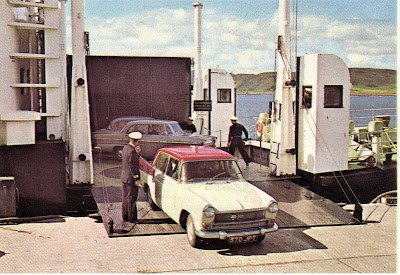Picture credit Hugh Spicer
The Hebridean Princess was built in Aberdeen in 1964 as the car ferry Columba. She was one of three identical sister ships - the others being named Hebrides and Clansman - built for David MacBrayne Ltd to inaugurate the first car ferry services on the west coast of Scotland beyond the Firth of Clyde (where car ferries had been operating since the mid 1950s).
An artist's impression of one of the three new ferries from MacBrayne's 1964 summer brochure
The Hebrides was allocated to a new route from Uig on Skye to Tarbert (Harris) and Lochmaddy (North Uist) in the Outer Hebrides and the Columba to a new route from Oban to Craignure on Mull and Lochaline in Morvern. The Clansman was intended as back-up to the other two ferries but in summer was placed on the non-essential Mallaig to Armadale (Skye) run to keep her busy when not required to deputise for her two sisters on their "lifeline" services.
The three views below - courtesy of Ken Connell - show the Columba at Lochaline shortly after she entered service on 30th July 1964
The black gantry, left, is for loading silica sand from the nearby mine on to cargo ships, not for boarding the Columba!
The Columba and her sisters technically belonged to the Secretary of State for Scotland and were chartered to MacBrayne's hence the port of registry at Leith rather than Glasgow as with all other ships in their fleet. In 1972, ownership passed to MacBrayne's and the port of registry was changed to Glasgow.
The Columba heads back towards Craignure and Oban
The original timetable and fares from MacBrayne's 1964 summer brochure
The initial summer schedule was four return sailings daily except Sunday to Craignure, two of which were extended to Lochaline. A motor coach came down from Tobermory via Salen to connect with the 10.45am sailing from Craignure to Oban and in the afternoon the coach met the Columba arriving at Craignure at 3.15pm to drive up to Tobermory. Thus did a combination of car ferry and motor coach replace the age old Sound of Mull mail steamer service which had sailed down from Tobermory every morning for Oban via calls at Salen, Lochaline and Craignure and returning in the afternoon.
The Columba and her sisters had capacity for 50 cars but they weren't ro-ro ferries of the sort familiar today where vehicles drive from the pier down a ramp adjustable to the height of the tide - called a "linkspan" - directly on to the ship's car deck. This is because ro-ro operations require investment in linkspans as well as ships and this wasn't considered justified on these "thin" routes on the west coast of Scotland in the early 1960s (c.f. the Channel and Irish Sea where ro-ro was well established in the 1950s).
Hence MacBraynes opted for the system adopted in the 50s by the Caledonian Steam Packet Company for their pioneering car ferries on the Clyde - "hoist-loading". With this system, which avoided the need for expensive linkspans, the ship was equippped with a vehicle lift which could be raised and lowered between the car deck and pier head. In the picture below of the Columba at Craignure, five cars have just been carefully positioned on the lift, the ramp is being raised and shortly it will descend to the car deck: a turntable in the floor of the lift will have helped the two cars nearest the camera be turned through 90 degrees and the car deck itself was liberally supplied with further turntables to assist the tricky manoeuvring required there to position the cars to be able to drive back onto the lift for disembarkation at the other end.
Being able to drive one's car on to the ship was a vast improvement on the previous generation of steamers with their capacity for only a dozen or so cars which had to be individually craned aboard as seen below in another memorable shot from Ken Connell's collection, this time of the MV Lochmor (1930) at Lochaline in 1964 just weeks before she was replaced by the Columba -
But there was no escaping the fact that hoist loading was cumbersome and slow - particularly for caravans and commercial vehicles. MacBrayne's scheduled 30 minutes for a turnround at Craignure (cf 15 minutes today for a much larger ro-ro ferry) but this was hopelessly optimistic for a full load and the ferries regularly fell way behind schedule.
In 1969, however, MacBrayne's was fully nationalised (hitherto it had been 50% owned by British Railways and 50% by Coast Lines, a private shipping company later taken over by P&O) and placed under the state transport quango, the Scottish Transport Group. The STG's aim was to convert all of Scotland's west coast ferry services to ro-ro as soon as possible and as part of this process, in 1973, the Oban to Craignure run was upgraded to ro-ro and the Columba's sister ship, Clansman, was converted to a ro-ro ferry. Hence in 1973 and 1974 the Columba moved north to operate the Clansman's summer only Mallaig to Armadale run. In 1973, she also sailed three times a week from Mallaig overnight to Lochboisdale in South Uist, this sailing continuing twice a week to Castlebay in Barra. (These Outer Hebridean sailings were not repeated in 1974 because that year a new ro-ro car ferry service was inaugurated from Oban to Castlebay and Lochboisdale.) In winter, the Columba became relief ferry.
Columba at Armadale, 1974 - Picture credit Phil Wilson
In 1973 also, the Columba and her sisters became the property of Caledonian MacBrayne, the company formed by the merger of MacBrayne's with the Clyde ferry operator, the Caledonian Steam Packet Company (which had also been taken over by the STG in 1969 having previously been 100% owned by British Railways).
In 1975, the Columba moved back to Oban to take up new summer duties but as this post is getting a bit over long, I'll come to this in the next episode.
In 1975, the Columba moved back to Oban to take up new summer duties but as this post is getting a bit over long, I'll come to this in the next episode.











No comments:
Post a Comment